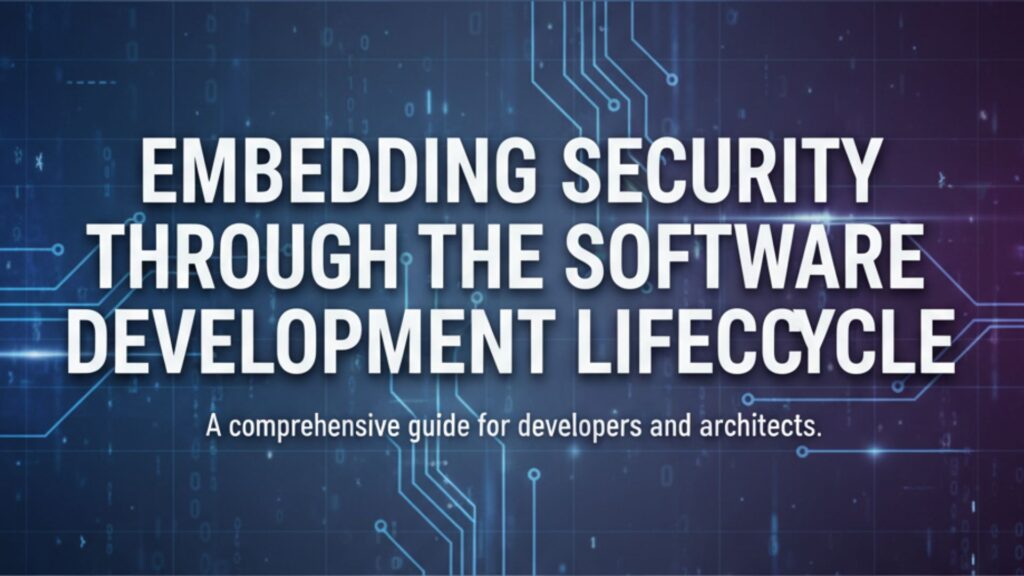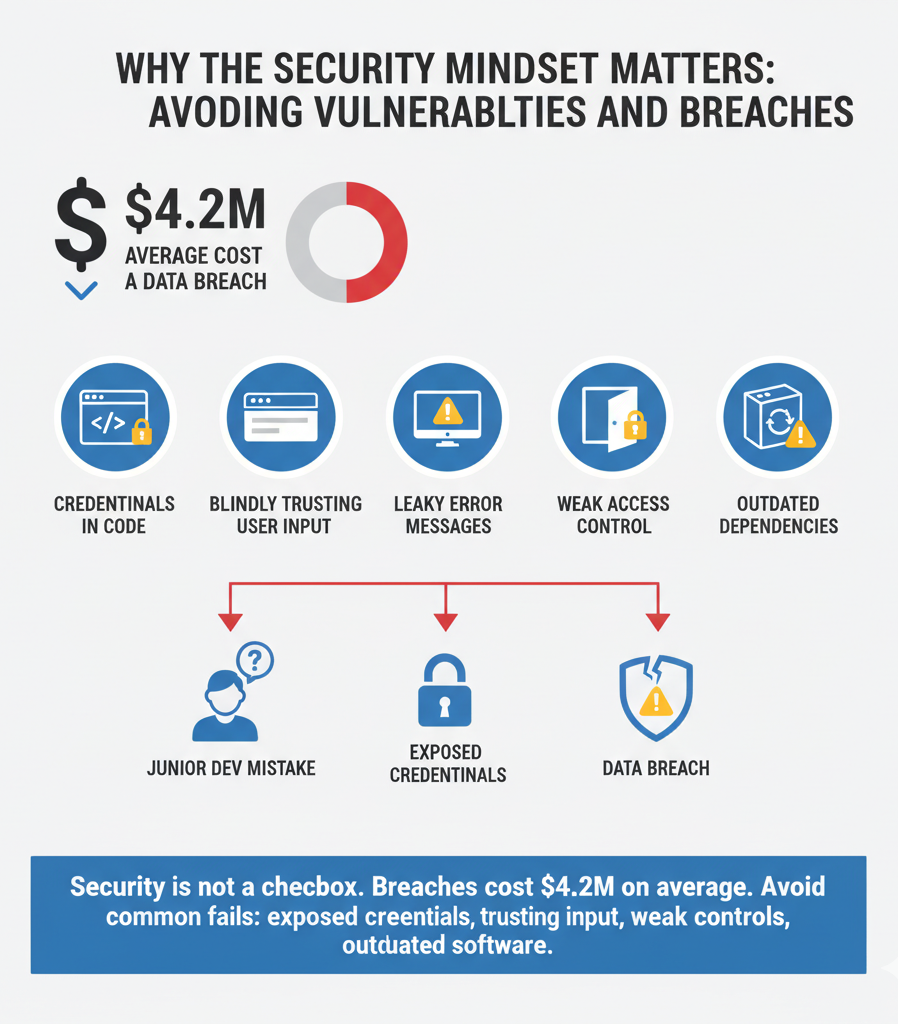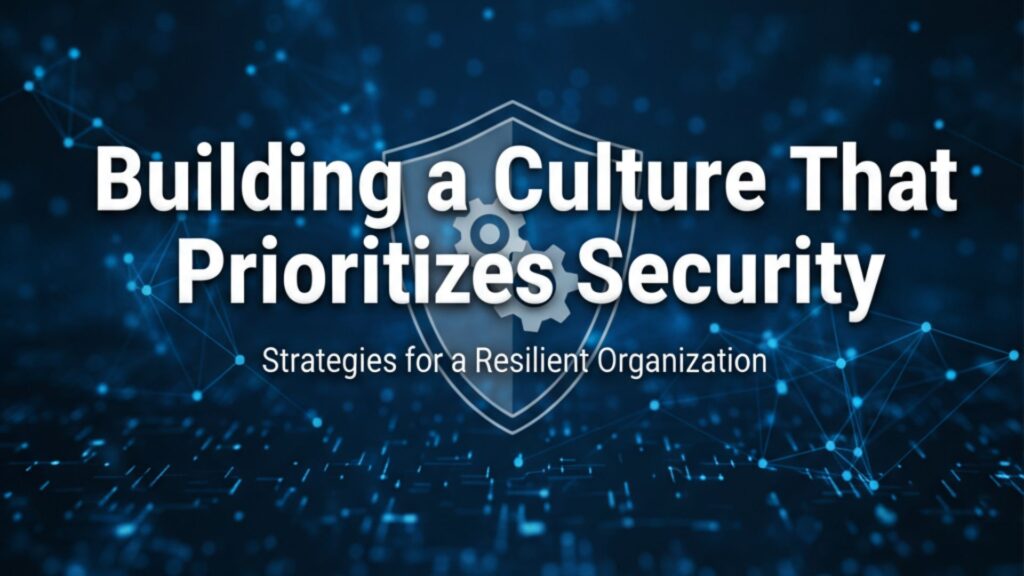
A good security mindset becomes second nature, like checking your mirrors before changing lanes. Our coding bootcamp students learn fast that simply getting code to run doesn’t cut it anymore. Threats evolve daily, and developers need sharp instincts to spot weak points before attackers do.
We’ve watched small security gaps turn into costly nightmares for companies. That’s why every line of code needs basic safeguards, input checks, data cleaning, and strict access controls. No exceptions.
Some coders see security as extra work. But done right, it’s just good engineering that protects real people using your systems.[1] Want to build code that actually holds up against today’s threats? Keep reading.
Key Takeaways
- Think like an attacker to spot weaknesses before they become problems
- Fix security issues early – it’s cheaper and smarter than patching later
- When the whole dev team owns security, the code gets stronger
What Is a Security Mindset in Coding?
Picture this: you’re building a house. You wouldn’t just focus on making it look nice – you’d make sure the doors lock and the windows are secure. That’s exactly what security-minded coding means. We teach our students to ask ‘what if?’ with every function they write, because developing a security mindset as a developer means thinking like an attacker from the start.
The bootcamp’s been around long enough to see plenty of attacks succeed. SQL injection brought down one client’s entire database. Another got hammered by cross-site scripting because nobody sanitized their inputs. Basic stuff, really. But it happens all the time.
Getting security right means baking it in from day one. Our developers don’t just tack on security features at the end – they’re thinking about protection while they’re still sketching out the code. Kind of like installing the locks while you’re building the door, not after.
Some basics we drill into every student:
- Map out where attacks might come from
- Write code that doesn’t trust any input
- Stay up to date on the newest tricks hackers use
Embedding Security Through the Software Development Lifecycle

Look, security isn’t something you can sprinkle on at the end like magic dust. We’ve watched too many teams try that approach, and it always ends badly. The smart move? Building security checks right into every step of development. Most of our students come in thinking security’s just another phase – they learn pretty quick it’s not.
Last year, one of our partner companies had to rebuild their entire payment system. Why? They didn’t think about security until after launch. Cost them nearly $200,000 in fixes, not counting lost business. That’s the kind of expensive lesson we help people avoid.
The whole team needs to own security – from the product folks sketching features to the ops team keeping things running. Our most successful graduates get their entire teams involved in security planning. Makes sense, right? More eyes on security means fewer holes for hackers to exploit.
Key security checkpoints we enforce:
- Threat modeling sessions before writing any code
- Security-focused code reviews (not just “does it work?”)
- Automated security scans (both static and dynamic)
- Regular penetration testing
- Security metrics tracking
Secure Coding Best Practices That Make a Difference
Nobody likes admitting their code might have holes. But here’s the truth: every input is a potential weapon, every feature a possible exploit. Our instructors spent years in the trenches before teaching, and they’ve seen it all. Some poor dev always thinks their input validation is good enough – until it’s not.
Three things matter most: First, treat all input like it’s toxic waste. Clean it, check it, validate it – every single time. Second, give users only the access they absolutely need. One of our students learned this when a test account with admin rights got compromised. Messy stuff. Third, handle errors gracefully. Don’t give attackers a peek under the hood when things break.
The bootcamp’s seen hundreds of developers come through. The ones who make it big? They’re the ones who make these practices automatic. Like muscle memory. Because when you’re debugging at 3 AM, you don’t want to be googling “how to prevent SQL injection.”
Why the Security Mindset Matters: Avoiding Vulnerabilities and Breaches

Numbers don’t lie. A single data breach costs companies an average of $4.2 million. That’s real money walking out the door because somebody didn’t check their code twice. We’ve had students come to us after their companies got hit – it’s never pretty.
Security isn’t just some box to check off. Back in 2021, one of our partner startups lost their entire customer database because a junior dev left credentials in a public GitHub repo. Basic stuff, really. But these things happen when teams rush and cut corners.[2]
The bootcamp’s seen every mistake in the book. SQL injection attacks still work because developers trust user input. System details leak through error messages because nobody thought about what they’re showing.
Most dangerous security fails we see:
- Credentials sitting in code repositories
- Trusting user input blindly
- Error messages that tell attackers too much
- Weak or missing access controls
- Outdated dependencies with known vulnerabilities
Developer Responsibilities and Continuous Learning
Writing secure code isn’t a one-and-done deal. The threat landscape changes faster than Silicon Valley job titles. Every day, some hacker figures out a new way to break things. That’s why our teaching never stops evolving.
The best developers think like attackers. In our advanced workshops, students try to break each other’s code – legally, of course. Nothing teaches security quite like watching your ‘unbreakable’ system fall apart in under five minutes, which is why our security mindset training program puts developers through real-world attack simulations.
Cross-team work matters more than most realize. When developers talk regularly with security folks and operations teams, everybody gets smarter. Our most successful graduates build these bridges early. They know that good security ideas can come from anywhere.
Common Security Pitfalls and How to Avoid Them
These mistakes keep showing up, like bad pennies. Last month, a team lost three days fixing a breach because someone hardcoded an API key right into their mobile app. Another company’s website got defaced because they didn’t sanitize file uploads. Real rookie stuff, but it happens to smart people who get careless.
The fix isn’t complicated, but it takes discipline. Every piece of user input needs checking – no exceptions. Passwords and keys belong in secure storage, not scattered through code files. And for heaven’s sake, don’t show users your error stack traces. Might as well hand attackers a roadmap.
Sometimes the simplest solutions work best. Our students learn to use environment variables, input validation libraries, and proper error handling from day one. Because when you’re building habits, you might as well build the right ones.
Advanced Practices for a Stronger Security Posture
Credit: Frank Stajano Explains
Most folks think basic input validation is enough – that’s like thinking a deadbolt alone keeps your house safe. Real security needs layers. During our advanced courses, students often get wide-eyed when they see how deep this rabbit hole goes.
Take threat modeling. It’s not just playing “what if” games – it’s about understanding how real attackers think. One of our recent graduates spotted a major vulnerability in their company’s API just by applying the threat modeling techniques we taught. Saved their startup from a potential nightmare.
Tools matter too. Our labs run constant security scans because manual code reviews can’t catch everything. Last month, an automated scan caught a nasty dependency vulnerability that had been sitting there for weeks. Nobody saw it during code reviews – but the scanner did.
The secret sauce is defense in depth. Like having a security system, cameras, AND good locks. When one thing fails (and something always does), you’ve got backups. We drill this into every student’s head: redundancy isn’t paranoia, it’s survival.
Building a Culture That Prioritizes Security

Look, you can’t force people to care about security. Trust us, we’ve tried. But something magical happens when teams start celebrating good security practices instead of treating them like chores.
At the bootcamp, we noticed teams that talk openly about security issues find more problems – and fix them faster. It’s not rocket science. When developers aren’t scared to say ‘hey, I think I found something weird here,’ everybody wins, it’s part of cultivating a security mindset that lasts beyond a single project.
Some of our partner companies even started security champion programs after sending folks through our training. They give out monthly awards for catching vulnerabilities, hold “hack your own code” sessions, and actually make security fun. Sounds crazy, right? But it works.
Here’s what really moves the needle:
- Regular security show-and-tell sessions
- Rewarding vulnerability reports
- Making security metrics visible
- Celebrating when teams catch issues early
- Building security reviews into sprint planning
Conclusion
No developer wants to be that person who left a gaping hole in the system. Looking at code through an attacker’s eyes changes everything – it’s like putting on night vision goggles in the dark. The basics aren’t rocket science: check what goes in, limit access rights, plan for things breaking.
Every line of code might be someone’s way in, so thinking about security shouldn’t be an afterthought. Smart teams make it part of their daily routine, just like morning coffee.
If you’re serious about leveling up your skills, building software that’s harder to break, and protecting the systems people trust you to create, don’t wait until after a breach to start learning. Join the Secure Coding Bootcamp today and make security part of your craft from day one.
FAQ
What does having a security mindset in coding really mean?
A security mindset in coding means thinking like an attacker while writing code. It ties closely to secure coding, software security, and cyber hygiene. Developers use secure design principles, input validation, output encoding, and buffer overflow prevention to stop mistakes early.
By focusing on risk analysis, threat modeling, and attack vector identification, teams reduce the attack surface. This approach also includes logging and auditing, insider threat detection, and using threat intelligence to predict risks. It’s less about fear and more about building a secure development culture where defense in depth becomes second nature.
How do secure coding guidelines connect with the secure software development lifecycle?
Secure coding guidelines are part of the secure software development lifecycle, also known as SSDLC. They cover things like SQL injection prevention, cross-site scripting, session management, secure error handling, and input sanitization. These rules help reduce code integrity risks and improve secure dependencies management.
Adding static analysis, dynamic analysis, and fuzz testing during security testing helps spot hidden issues. Continuous security integration, software composition analysis, and security vulnerability management strengthen overall DevSecOps efforts. In practice, these steps support secure update mechanisms, secure deployment practices, and compliance standards to keep software security strong from design to release.
Why do developers rely on tools like penetration testing and code review?
Penetration testing, threat simulation, and incident simulation let teams see how real attackers might break systems. Code review, combined with static analysis and dynamic analysis, catches weak spots before they go live. Together, they support vulnerability assessment, attack surface reduction, and risk mitigation. Security champions often lead these efforts to keep everyone sharp.
Security automation, secure configurations, and secure APIs also play a role. Strong cyber resilience depends on defense in depth and secure communication protocols, backed by cryptographic standards, encryption techniques, and authentication mechanisms. These practices help spot weaknesses early and build trust in code integrity.
How do DevSecOps and zero trust security improve cyber resilience?
DevSecOps builds security into daily work, using security policy enforcement, security metrics, and security orchestration to streamline protection. Zero trust security adds multi-factor authentication, access control, least privilege, and secure network programming to cut risks. Together, they improve endpoint security, network segmentation, secure communication protocols, and cloud security best practices.
Cyber resilience grows stronger with secure APIs, secure deployment practices, secure configurations, and defense in depth. Teams also focus on supply chain security, secure dependencies management, and malware defense. Security governance and secure development culture ensure practices last, while secure update mechanisms and bug bounty programs keep systems safe.
What role does security awareness training play in software security?
Security awareness training helps developers think with a penetration mindset. It connects human decisions to secure design principles, secure coding guidelines, and privacy by design. Training shows how simple choices, like secure error handling, session management, or access control, support data protection and encryption techniques.
It also teaches about secure communication protocols, secure network programming, and secure deployment practices. Developers learn about OWASP top 10 issues, code obfuscation risks, and insider threat detection. By focusing on secure configurations, secure APIs, and secure dependencies management, teams build habits. Over time, threat intelligence, incident response, and security monitoring become natural parts of daily work.
References
- https://en.wikipedia.org/wiki/Secure_coding
- https://www.researchgate.net/publication/348915485_How_Bad_Can_It_Git_Characterizing_Secret_Leakage_in_Public_GitHub_Repositories

